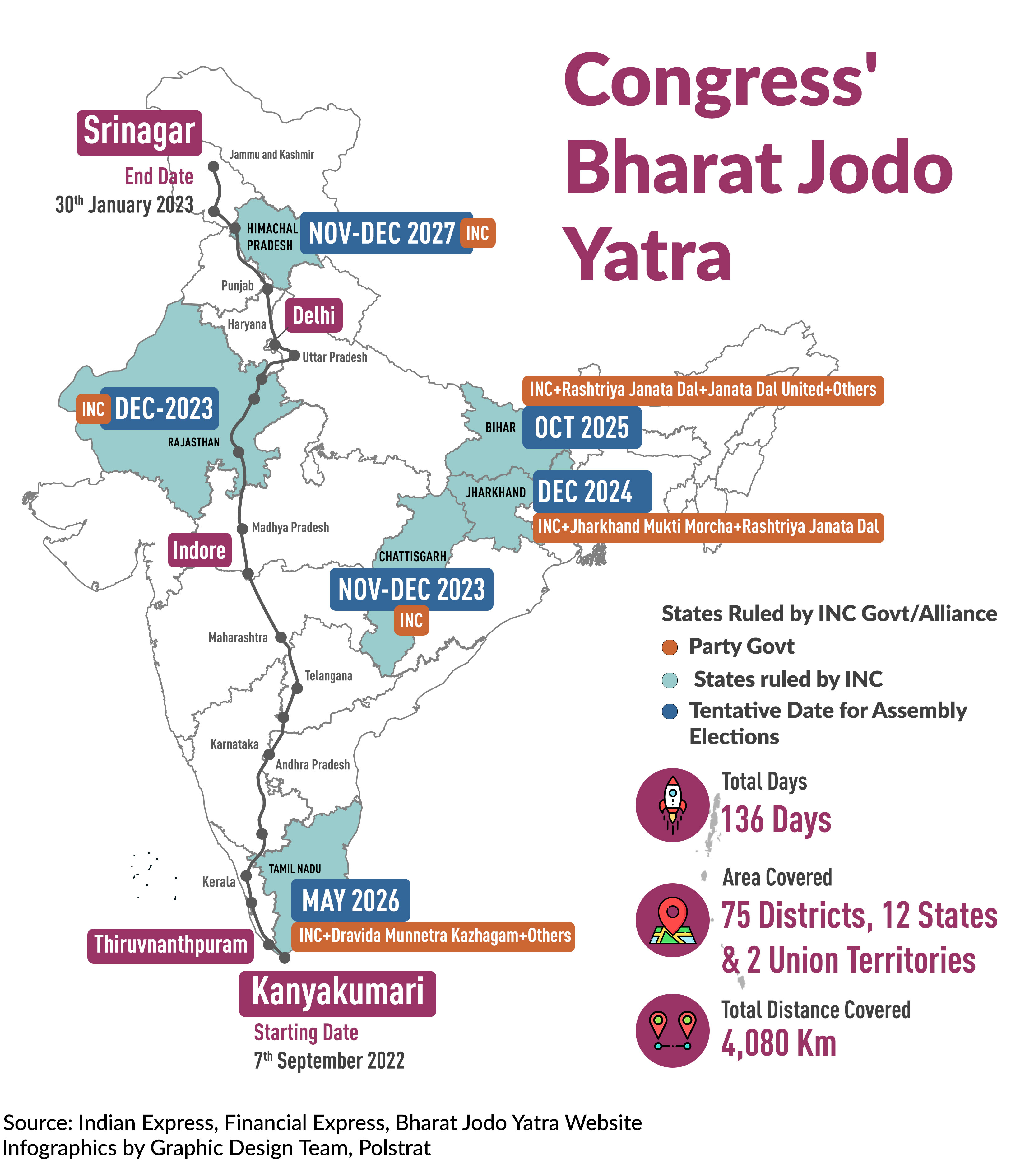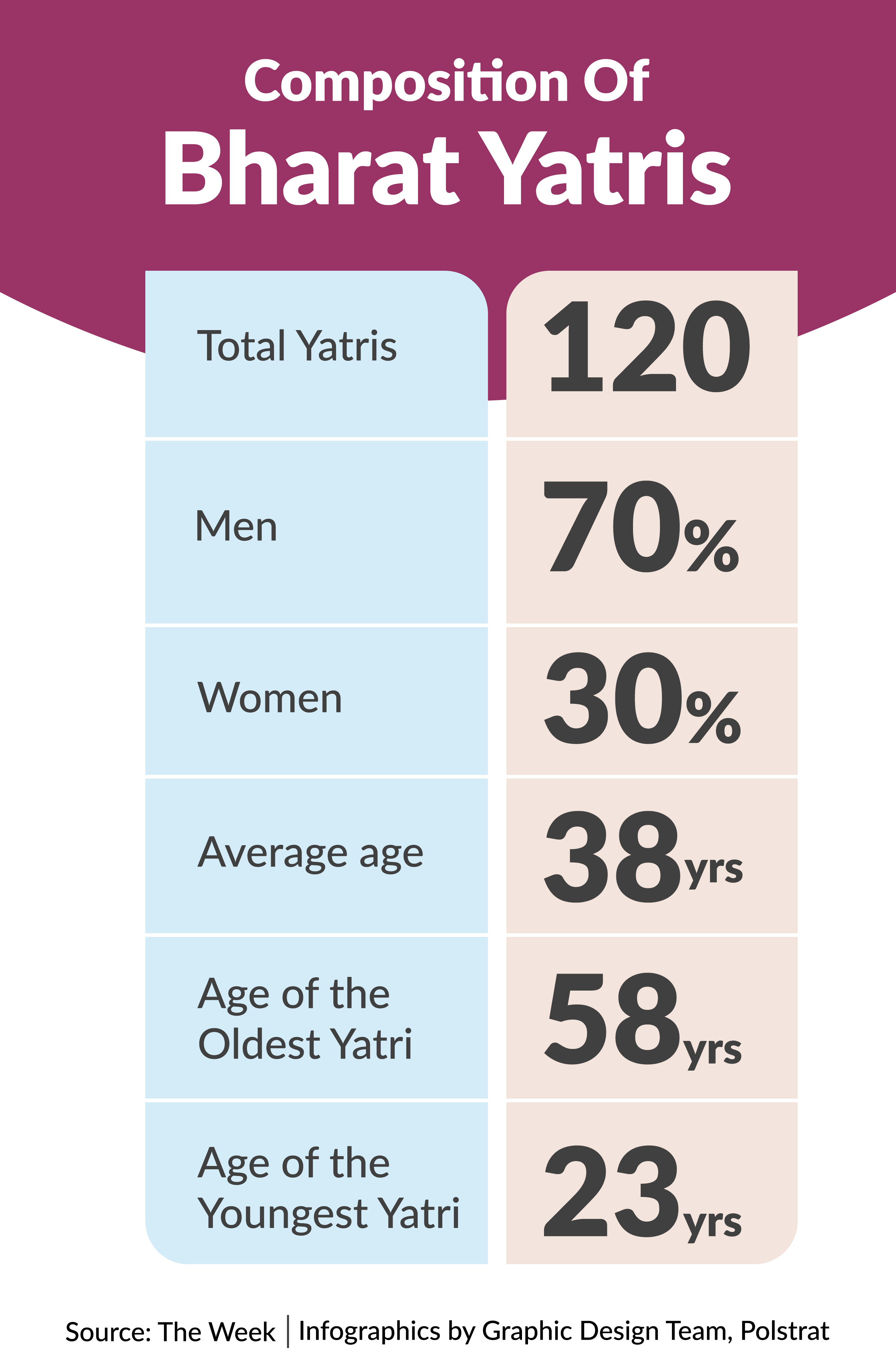
The Indian National Congress recently completed its Bharat Jodo Yatra in Jammu and Kashmir amidst much fanfare and the support of eight opposition parties, members of which attended the closing event. The Yatra was led by former party President Rahul Gandhi who termed it a non-political undertaking, an act aimed at unifying the country, and meant to “affirm love and unity in times of hatred and disunity”.
The Yatra, which began on 7th September 2022 from Kanyakumari in Tamil Nadu traversed through 12 states and two union territories over the course of its 136-day journey while skipping key poll-bound states like Gujarat. According to political analysts, the Yatra has been likened to a reformation of Rahul Gandhi’s image but might do little to benefit the Congress which is in dire need of strong reorganisation across the country.
Although the Yatra was undertaken as nonpolitical, it courted several controversies across its nearly five-month journey. The Bharatiya Janata Party (BJP) first dismissed, then took head-on, every aspect of the Yatra, from questioning the people Gandhi met to statements made by Congress leaders such as Digvijiay Singh. We summarise the Bharat Yodo Yatra’s journey over the past few months, the next steps for the Congress in the form of the ‘Hath se Hath Jodo Yatra’, and what it means for the party before the upcoming Assembly and next Lok Sabha Elections.

Analysing the 136-Day Journey
Courting Controversy Over 4,080 Kms In September 2022, Congress leader Rahul Gandhi kicked off the Bharat Jodo Yatra from Tamil Nadu. He first paid homage at the Sriperumbudur memorial near Chennai, the site of the assassination of his father Rajiv Gandhi in 1991 and later addressed a rally from Kanyakumari to officially launch the Yatra.
According to the party, the Yatra was an attempt to provide an alternative to the current politics of “fear, bigotry and prejudice” and to the economics of livelihood destruction, increasing unemployment and growing inequalities.
The Yatra was in the form of a foot march covering 12 states – all the way from India’s southern tip, Kanyakumari, to Srinagar in the north, and was undertaken with a tagline of “mile kadam, jude vatan” (walk together, unite the country). Covering 4,080 kilometres across the length and breadth of the country, the Yatra is the first mass-mobilisation event conducted by the party in decades and was accompanied by separate small Yatras in the states of Assam, Tripura, Bihar, Odisha, Sikkim, West Bengal, and Nagaland.

Gandhi addressed 12 public meetings, over 100 corner meetings, and 13 press conferences during the five-month journey. He also took part in more than 275 planned walking interactions and more than 100 sitting interactions during the Yatra. According to political observers, the Yatra has largely acted as an image makeover for the leader as he emerged as a more active and compassionate individual who will not be cowed down by the BJP’s politics, challenging the party’s narrative every step of the way.
Courting Controversy Over 4,080 Kms In September 2022, Congress leader Rahul Gandhi kicked off the Bharat Jodo Yatra from Tamil Nadu. He first paid homage at the Sriperumbudur memorial near Chennai, the site of the assassination of his father Rajiv Gandhi in 1991 and later addressed a rally from Kanyakumari to officially launch the Yatra. According to the party, the Yatra was an attempt to provide an alternative to the current politics of “fear, bigotry and prejudice” and to the economics of livelihood destruction, increasing unemployment and growing inequalities. The Yatra was in the form of a foot march covering 12 states – all the way from India’s southern tip, Kanyakumari, to Srinagar in the north, and was undertaken with a tagline of “mile kadam, jude vatan” (walk together, unite the country).
Covering 4,080 kilometres across the length and breadth of the country, the Yatra is the first mass-mobilisation event conducted by the party in decades and was accompanied by separate small Yatras in the states of Assam, Tripura, Bihar, Odisha, Sikkim, West Bengal, and Nagaland. Gandhi addressed 12 public meetings, over 100 corner meetings, and 13 press conferences during the five-month journey. He also took part in more than 275 planned walking interactions and more than 100 sitting interactions during the Yatra.
According to political observers, the Yatra has largely acted as an image makeover for the leader as he emerged as a more active and compassionate individual who will not be cowed down by the BJP’s politics, challenging the party’s narrative every step of the way. Courting controversy over its long journey, the Yatra saw figures such as former Reserve Bank of India (RBI) governor Raghuram Rajan and former Research and Analysis Wing (R&AW) secretary Amarjit Singh Dulat sharing the stage with Gandhi. The BJP challenged Rajan’s presence at the Yatra as BJP National General Secretary CT Ravi called it an effort by Rajan to repay his debt to the dynasty (Gandhis) for making him the RBI Governor.
Questioning Dulat’s entry into the Yatra on 3rd January 2023, BJP leaders were quick to probe the former spymaster’s role in “Kashmir’s fiasco” and his association with Gandhi at the Yatra. Gujarat chief minister and BJP leader Bhupendra Patel labelled the Yatra as “antiGujarati”, after social rights activist Medha Patkar, who spearheaded the Narmada Bachao Andolan against the Gujarat government, marked her presence at the Yatra as well.
The Yatra traversed through 75 districts and saw the BJP challenge it during its other legs too. Senior Congress leader Digvijaya Singh’s catch sizing the BJP government’s claims on surgical strikes led to an inflamed response from the latter calling it an insult to both Prime Minister Modi and the Indian Armed Forces. To avoid further controversy, Rahul Gandhi dismissed Singh’s remarks as being his personal opinion and not the official stand of the party.